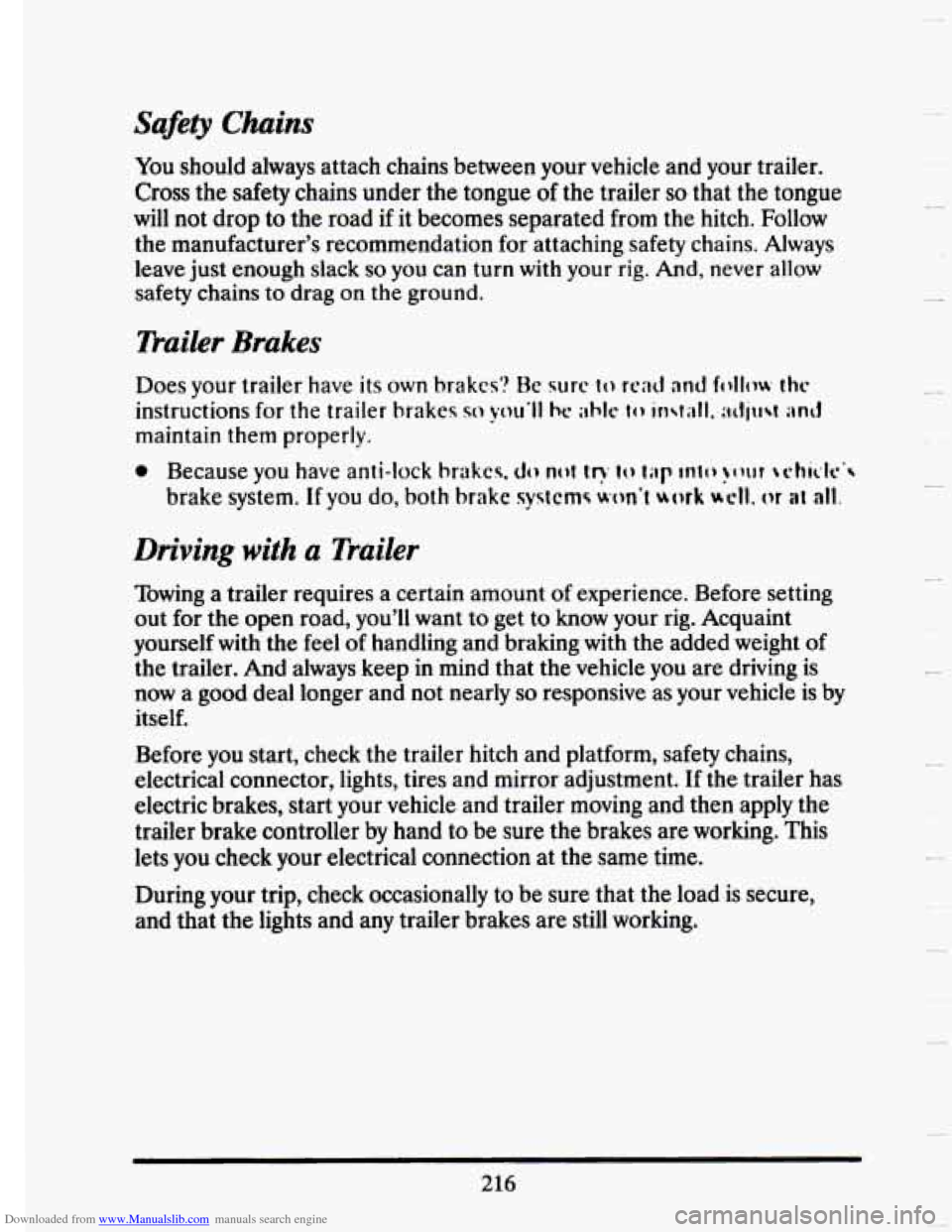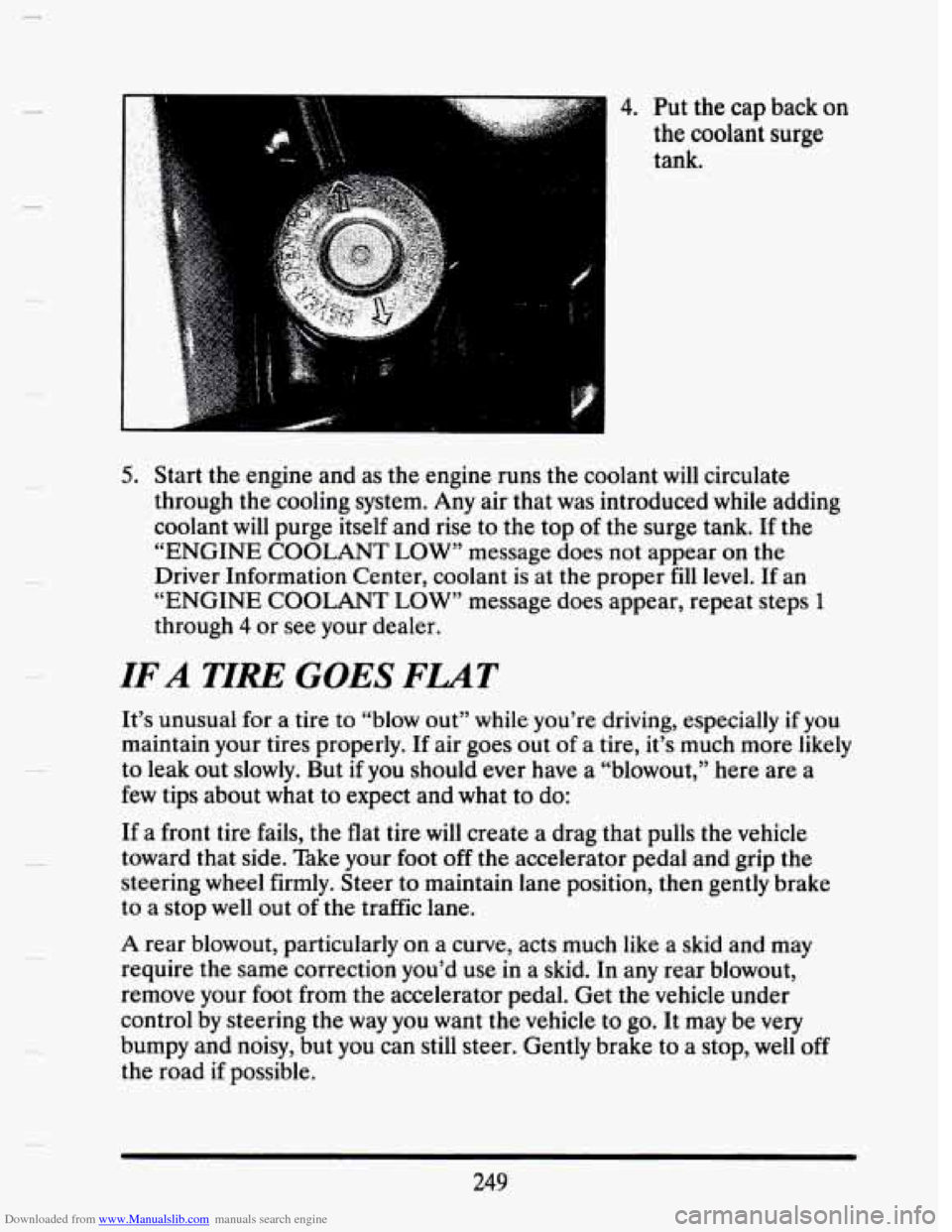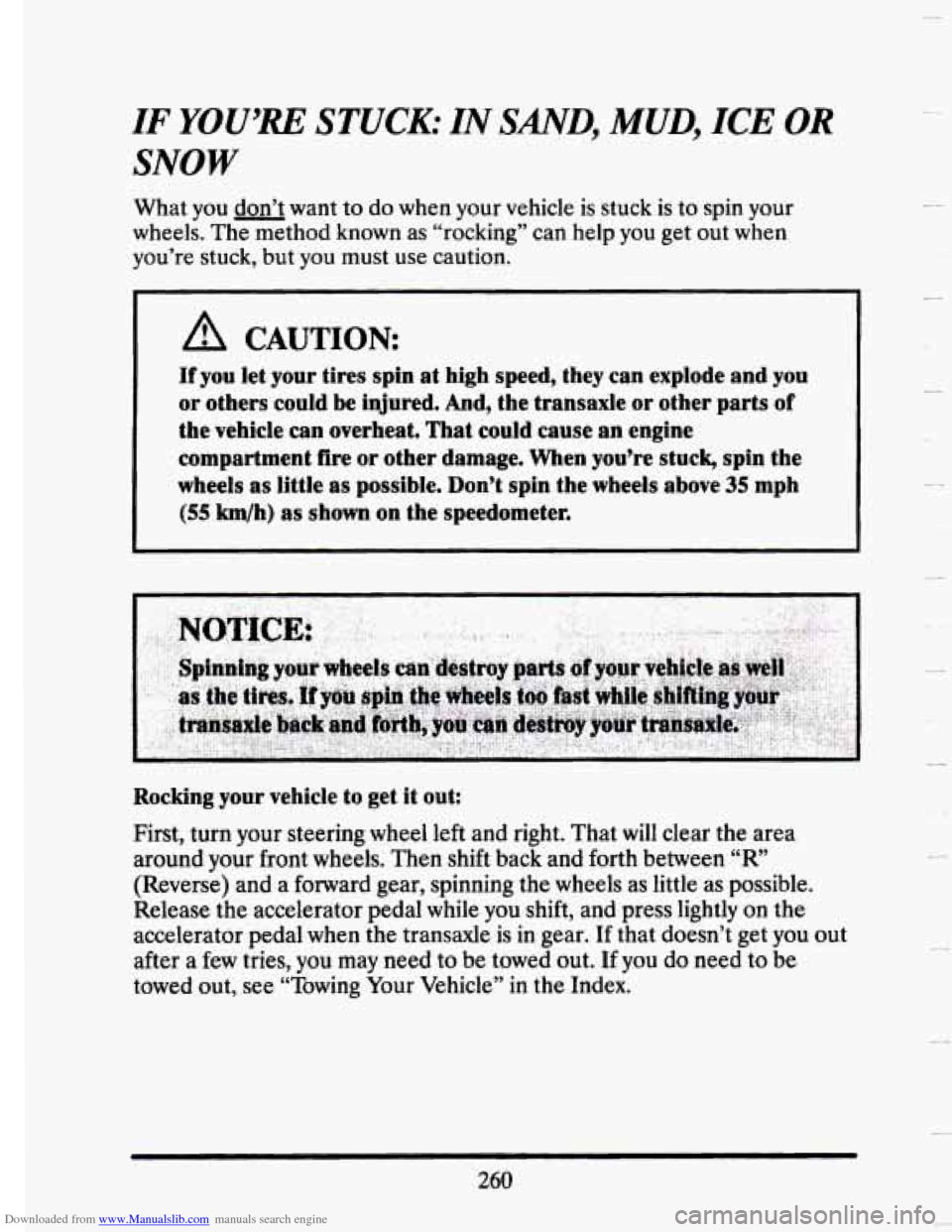Page 227 of 407

Downloaded from www.Manualslib.com manuals search engine TOWNG A TRAlrLER
A CAUTION:
If you don’t use the correct equipment and drive properly, you
can lose control when you pull
a trailer. For example, if the
trailer is too heavy, the brakes may not work well
-- or even at
all. You and your passengers could be seriously injured. Pull a
trailer only if you have followed all the steps in this section.
Load-pulling components such as the engine, transaxle, wheel assemblies,
and tires are forced
to work harder against the drag of the added weight.
The engine is required to operate at relatively higher speeds and under
greater loads, generating extra heat. What’s more, the trailer adds
considerably to wind resistance, increasing the pulling requirements.
All
of that means changes in:
e Handling
Durability
Fuel economy
If You Do Decide To Pull A Trailer
If you do, here are some important points.
There are many different laws having to do with trailering. Make sure
your rig
will be legal, not only where you live but also where you’ll be
driving. A good source for this information can be state or provincial
police.
213
Page 229 of 407

Downloaded from www.Manualslib.com manuals search engine I
..
I -A
I ..
The trailer tongue (A) should weigh 10% of the total loaded trailer
weight
(B). After you’ve loaded your trailer, weigh the trailer and
then the tongue, separately,
to see if the weights are proper. If they
aren’t, you may be able to get them right simply by moving some
items around in the trailer.
3. Total Weight on Your Vehicle’s Tires
Be sure your vehicle’s tires are inflated to the limit for cold tires.
You’ll find these numbers on the Certification label at the rear edge
of the driver’s door (or see Index under “Tire Loading”). Then be
sure you don’t
go over the GVW limit for your vehicle.
Hitches
It’s important to have the correct hitch equipment. Crosswinds, large
trucks going by, and rough roads are a few reasons why you’ll need the
right hitch. Here are some rules to follow:
0 Will you have to make any holes in the body of your vehicle when you
install
a trailer hitch? If you do, then be sure to seal the holes later
when you remove the hitch. If you don’t seal them, deadly carbon
monoxide (CO) from your exhaust can get into your vehicle (see
Index under “Carbon Monoxide”). Dirt and water can, too.
The bumpers on your vehicle are not intended for hitches. Do not
attach rental hitches or other bumper-type hitches to them.
215
Page 230 of 407

Downloaded from www.Manualslib.com manuals search engine Safety Chains
You should always attach chains between your vehicle and your trailer.
Cross the safety chains under the tongue
of the trailer so that the tongue
will not drop to the road if it becomes separated from the hitch. Follow
the manufacturer's recommendation for attaching safety chains. Always
leave just enough slack
so you can turn with your rig. And, never allow
safety chains to drag
on the ground.
Trailer Brakes
Does your trailer have its own brakcs'? He sure IO read and follow thc
instructions for the trailer brakes so you'll he ilblc to ir~ i~lI, ;rcliw an3
maintain them properly.
Driving with a Trailer
Towing a trailer requires a certain amount of experience. Before setting
out for the open road, you'll want to get to
know your rig. Acquaint
yourself with the feel of handling and braking with the added weight of
the trailer. And always keep
in mind that the vehicle you are driving is
now a good deal longer and not nearly so responsive as your vehicle is by
itself.
Before you start, check the trailer hitch and platform, safety chains,
electrical connector, lights, tires and mirror adjustment. If the trailer has
electric brakes, start your vehicle and trailer moving and then apply the
trailer brake controller by hand
to be sure the brakes are working. This
lets
you check your electrical connection at the same time.
During your trip, check occasionally to be sure that the load is secure,
and that the lights and any trailer brakes are still working.
216
L -4
c
L-
L-
C
Page 244 of 407
Downloaded from www.Manualslib.com manuals search engine If your vehicle has been changed or modified since it was factory-new by
adding aftermarket items like fog lamps, aero skirting, or special tires and
wheels, these instructions and illustrations may not be correct.
Before
you do anything, turn on the hazard warning flashers.
When
you call, tell the towing service:
That your vehicle cannot be towed from the front or rear with
That your vehicle has front-wheel drive.
sling-type
equipment.
The make, model, and year of your vehicle.
Whether you can still move the shift lever.
If there was an accident, what was damaged.
When the towing service arrives, let the tow operator know that this
manual contains detailed towing instructions and illustrations. The
operator may want to see them.
230
L
Y
c
CI
Page 263 of 407

Downloaded from www.Manualslib.com manuals search engine . : 4. Put the cap back on
the coolant
surge
tank.
5. Start the engine and as the engine runs the coolant will circulate
through the cooling system. Any air that was introduced while adding
coolant
will purge itself and rise to the top of the surge tank. If the
“ENGINE COOLANT
LOW” message does not appear on the
Driver Information Center, coolant is at the proper
fill level. If an
“ENGINE
COOLANT LOW” message does appear, repeat steps 1
through 4 or see your dealer.
IFA TIRE GOES FLAT
It’s unusual for a tire to “blow out” while you’re driving, especially if you
maintain your tires properly. If air goes out of a tire, it’s much more likely
to leak out slowly. But if you should ever have a “blowout,” here are a
few tips about what to expect and what
to do:
If a front tire fails, the flat tire will create a drag that pulls the vehicle
toward that side. Take your foot off the accelerator pedal and grip the
steering
wheel firmly. Steer to maintain lane position, then gently brake
to a stop
well out of the traffic lane.
A rear blowout, particularly on a curve, acts much like a skid and may
require the same correction you’d use in a skid. In any rear blowout,
remove your foot from the accelerator pedal. Get the
vehicle under
control by steering the way you want the vehicle to
go. It may be very
bumpy and noisy, but you can still steer. Gently brake to a stop,
well off
the road if possible.
3
249
Page 273 of 407
Downloaded from www.Manualslib.com manuals search engine I!
Don’t use your compact spare on some other vehicle.
P
And don’t mix your compact spare or wheel with other wheels or tires.
They won’t
fit. Keep your spare and its wheel together.
i
P
r 1 I
I I
A CAUTION
Storing a jack, a tire, or oth’er equipment in the pagsenger
compartment
of the vehicle could cause iqjury. In a sudden stop
or collision, loose equipment could strike someone. Store all
these in the proper place.
The flat tire should be placed in the spare tire well.
259
Page 274 of 407

Downloaded from www.Manualslib.com manuals search engine IF YOU’RE STUCK: IN SAND, MUD, ICE OR
SNOW
What you don’t want to do when your vehicle is stuck is to spin your
wheels.
The method known as “rocking” can help you get out when
you’re stuck,
but you must use caution.
I A CAUTION
If you let your tires spin at high speed, they can explode and you
or others could be injured.
And, the transaxle or other parts of
the vehicle can overheat. That could cause an engine
compartment
fire or other damage. When you’re stuck, spin the
wheels
as little as possible. Don’t spin the wheels above 35 mph
(55 km/h) as shown on the speedometer.
Rocking your vehicle to get it
out:
First, turn your steering wheel left and right. That will clear the area
around your front wheels. Then shift back and forth between “R”
(Reverse) and
a forward gear, spinning the wheels as little as possible.
Release the accelerator pedal while
you shift, and press lightly on the
accelerator pedal when the transaxle
is in gear. If that doesn’t get you out
after a few tries, you may need to be towed out. If you do need to be
towed out,
see “Towing Your Vehicle” in the Index.
260
i
Y
-
c--
..
Page 318 of 407
Downloaded from www.Manualslib.com manuals search engine LOplDING YOUR KEHICLE
TIRE-LOADING INFORMATION
‘m OCCUPANTS VEHICLE CAP. WT.
FRT. CTR. RR. TOTAL LBS. KG
MAX. LOADING & GVWR SAME AS VEHICLE
CAPACITY WEIGHT
XXX COLD TIRE
TIRE SIZE SPEED PRESSURE
RTG PSVKPa
FRT.
RR.
SPA.
IF TtRES ARE
HOT. ADD 4PS1/28KPa SEE
OWNER’S MANUAL FOR ADDITIONAL
INFORMATION
GEN GME,
Two labels on your vehicle show how much weight it may properly carry.
The Tire-Loading Information label found on the driver’s ddor tells you
the proper
size, speed rating and recommended inflation pressures for
the tires on your vehicle.
It also gives you important information about
the number
of people that can be in your vehicle and the total weight that
you can carry. This weight
is called the Vehicle Capacity Weight and
includes the weight of
all occupants, cargo, and all nonfactory-installed
options.
304
.-
I